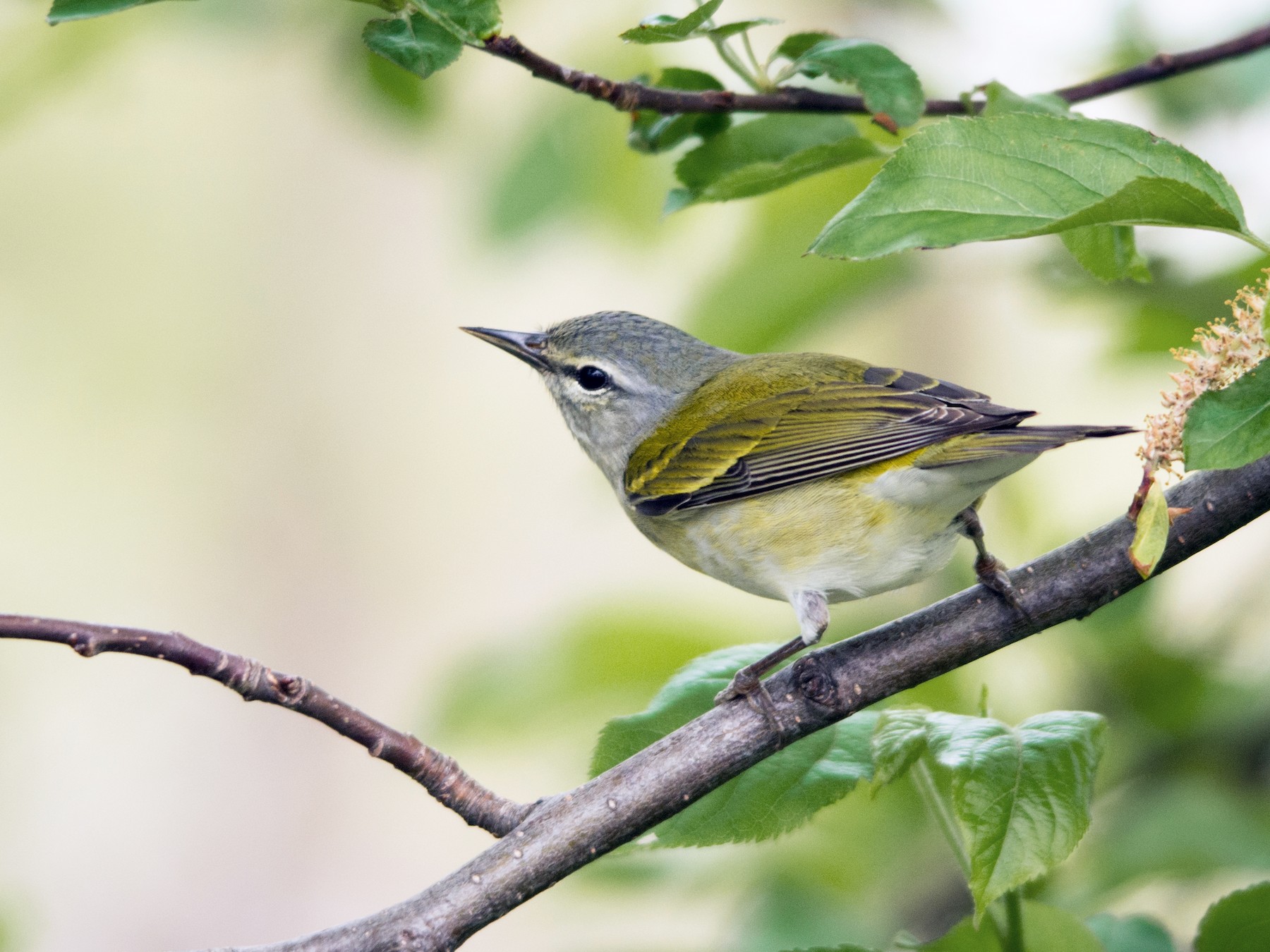Spring and summer in Louisiana witness the arrival of warblers and orioles, bringing with them a plethora of yellow birds. However, during the winter season, different yellow birds migrate to the region, seeking the warmer climate, and some even decide to stay all year round due to the favorable conditions.
To assist you in identifying the yellow birds you spot in Louisiana, this comprehensive guide presents pictures, identification information, song recordings, as well as migration patterns.
The majority of yellow birds found in Louisiana are warblers, orioles, and tanagers, with the occasional presence of female birds that exhibit distinct appearances from their male counterparts.
By utilizing the information provided in this guide, identifying yellow birds in Louisiana will become a much simpler task. The list of yellow birds is arranged in the order of their common sightings in the state during spring and summer, based on ebird checklists for May and June.
Yellow birds found in Louisiana throughout the year include the Pine Warbler, Common Yellowthroat, and Eastern Meadowlark.
During the summer season, you can expect to encounter White-eyed Vireo, Summer Tanager, Orchard Oriole, Prothonotary Warbler, Hooded Warbler, Painted Bunting, Yellow-throated Vireo, Baltimore Oriole, Yellow-throated Warbler, Dickcissel, and Prairie Warbler.
As for the winter season, keep an eye out for the Yellow-rumped Warbler, American Goldfinch, Orange-crowned Warbler, Cedar Waxwing, Palm Warbler, Wilson’s Warbler, Western Kingbird, Yellow-headed Blackbird, and Western Meadowlark.
Yellow birds passing through Louisiana during migration periods include the Yellow Warbler, American Redstart, Magnolia Warbler, Scarlet Tanager, Black-throated Green Warbler, Blue-winged Warbler, Nashville Warbler, Canada Warbler, and Cape May Warbler.
Lastly, there are the accidental sightings of Yellow birds in Louisiana, which include the Western Tanager, Couch’s Kingbird, Tropical Kingbird, Evening Grosbeak, Scott’s Oriole, Lesser Goldfinch, and Hooded Oriole.
Now, read on to successfully identify those delightful yellow birds you have spotted!
In Louisiana, a total of 32 yellow birds can be found. Let’s dive into the details of some of these fascinating species:
1. Yellow-rumped Warbler:
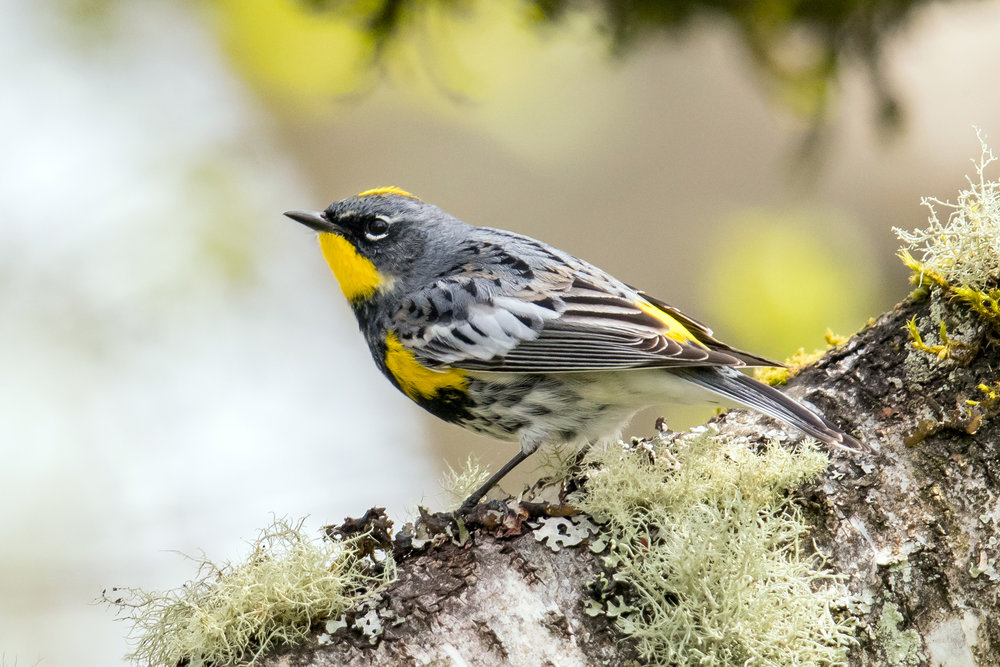
These winter birds arrive in Louisiana starting from September, with some staying until May. The prime months to spot them are from October to April. They display gray plumage with flashes of yellow on the face, sides, and rump, along with white wings. Female birds may appear slightly brown, and winter individuals exhibit paler brown shades, with bright yellow rumps and sides that transition back to gray in spring.
Yellow-rumped Warblers, scientifically known as Setophaga coronata, primarily breed in Canada, the Rockies, and the Appalachian mountains. They migrate through the Midwest and overwinter in southern and southwestern US states, along the Pacific Coast, and down to Mexico and Central America. These birds can be found in coniferous forests during the breeding season, open areas with fruiting shrubs during winter, and mainly feed on insects during summer and migration, and fruit during winter, including bayberry and wax myrtle.
2. White-eyed Vireo:

White-eyed Vireos can be observed in Louisiana from April to October, during the breeding season. Approximately 22% of checklists during the summer include sightings of this species. However, some individuals remain in the state throughout the year. These vireos possess gray heads with yellow forehead patches, white eyes, white chests and throats, yellow sides, greenish backs with darker wings, and two white wingbars.
Scientifically known as Vireo griseus, White-eyed Vireos spend their summers across the southeastern United States, concealed within thickets. Those near the coast tend to stay in Louisiana year-round, while they migrate south along the southeastern coast of Mexico and the Caribbean for winter. Their preferred habitats include overgrown pastures, brambles, and areas with insects like flies and spiders. During winter, they also consume berries.
3. American Goldfinch:
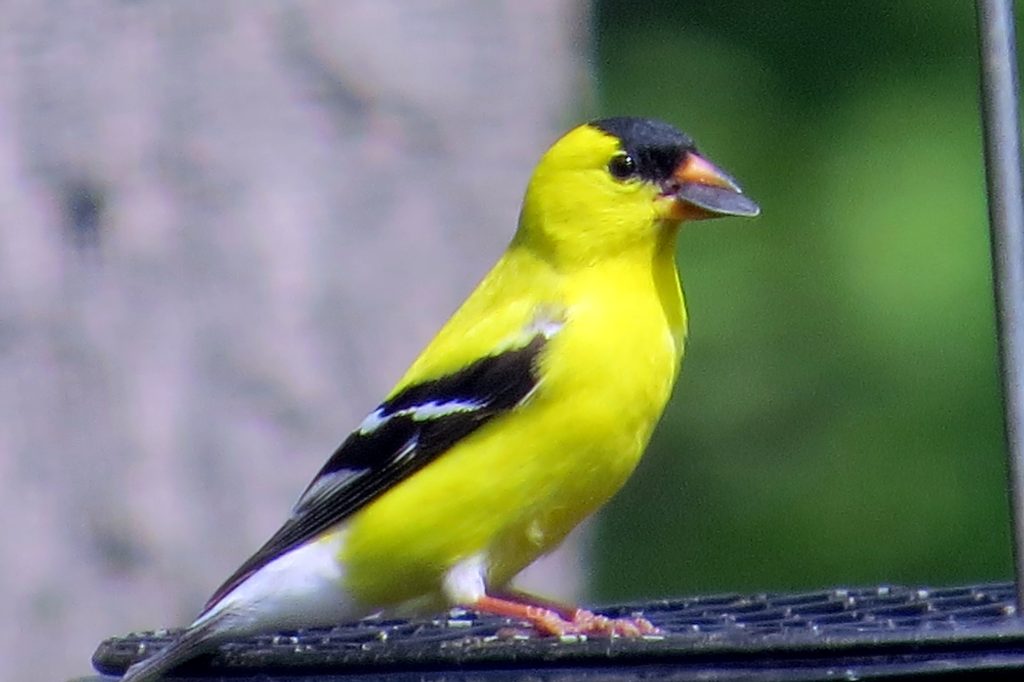
American Goldfinches rank as the second most frequently observed yellow birds in Louisiana during winter. They are commonly seen between November and mid-May and appear in approximately 32% of winter checklists. These finches are beloved for the vibrant black and bright yellow plumage of males during spring, while females and winter males exhibit a duller brown appearance.
Scientifically referred to as Spinus tristis, American Goldfinches can be found across most of North America and are typically resident throughout the year. However, the individuals breeding in Canada and the Midwest migrate to southern US states for winter. They forage in weedy fields, overgrown areas, suburbs, parks, and backyards, focusing on sunflower, thistle, and aster plants. American Goldfinches build their nests in shrubs using rootlets, plant material, and spiders’ webs, and they lay up to seven eggs, which take around two weeks to hatch, with an additional two or two and a half weeks for the young to fledge.
4. Pine Warbler:
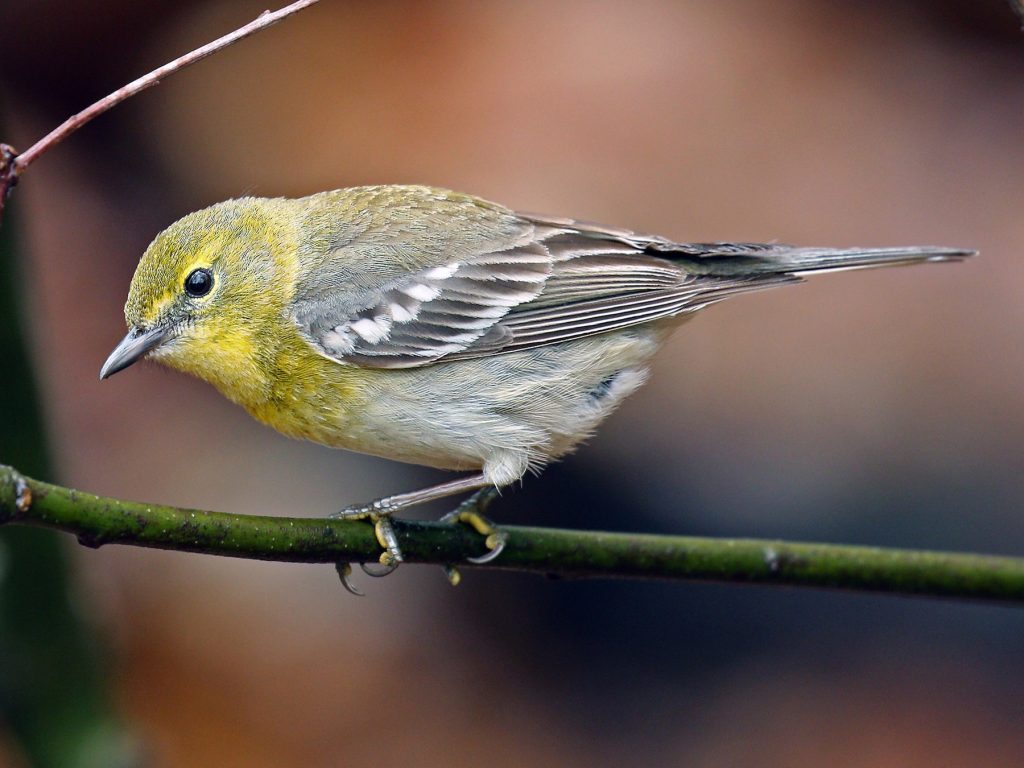
Pine Warblers spend their winters in southern Louisiana, while some individuals remain in the northern part of the state throughout the year. They are recorded in 10% of summer checklists and 20% of winter checklists provided by birdwatchers in Louisiana. These plump yellow birds feature olive backs, white lower bellies, gray wingbars, and females may appear browner with more white on their bellies.
Scientifically named Setophaga pinus, Pine Warblers breed in the northeastern United States before migrating to southeastern US states. Some individuals remain in the southeastern states throughout the year. These warblers primarily inhabit pine forests, residing high up in the trees. Their diet consists mainly of caterpillars, beetles, spiders, and other insects and larvae. During colder weather, they also feed on fruit and seeds.
5. Orange-crowned Warbler:

Orange-crowned Warblers are winter visitors to Louisiana, typically seen from mid-September until April. They are observed in approximately 26% of checklists during this period. These warblers possess yellow-olive coloring, with the yellow shade more prominent on the Pacific Coast. Their orange crown is rarely visible.
Scientifically classified as Leiothlypis celata, Orange-crowned Warblers breed in Canada and western US states, migrating to the Pacific, East, and Gulf Coasts, as well as Mexico. During migration, they can be found in almost all US states, except the northeastern region. These warblers frequent shrubs, low vegetation, and open woodlands, with their diet primarily consisting of spiders and insects such as caterpillars and flies. They also consume fruit, berries, and seeds and readily visit backyard feeders.
6. Common Yellowthroat:

Common Yellowthroats can be found in southern Louisiana throughout the year, while they are more commonly seen in the northern part of the state during the breeding season. Approximately 15% of summer checklists and 8% of winter checklists report sightings of these yellowthroats.
Common Yellowthroats are small songbirds with brownish backs, bright yellow undersides, and long tails. Males exhibit black masks across their faces. The brightness of their yellow plumage can vary geographically, with some populations appearing more
olive underneath.
Scientifically known as Geothlypis trichas, Common Yellowthroats breed across most of North America, excluding Alaska and northern Canada. Some individuals remain along the Gulf Coast and Pacific Southwest throughout the year, while others migrate south for winter. These yellowthroats can often be found in marshy or wetland areas, living amidst thick, tangled vegetation.
7. Eastern Meadowlark:
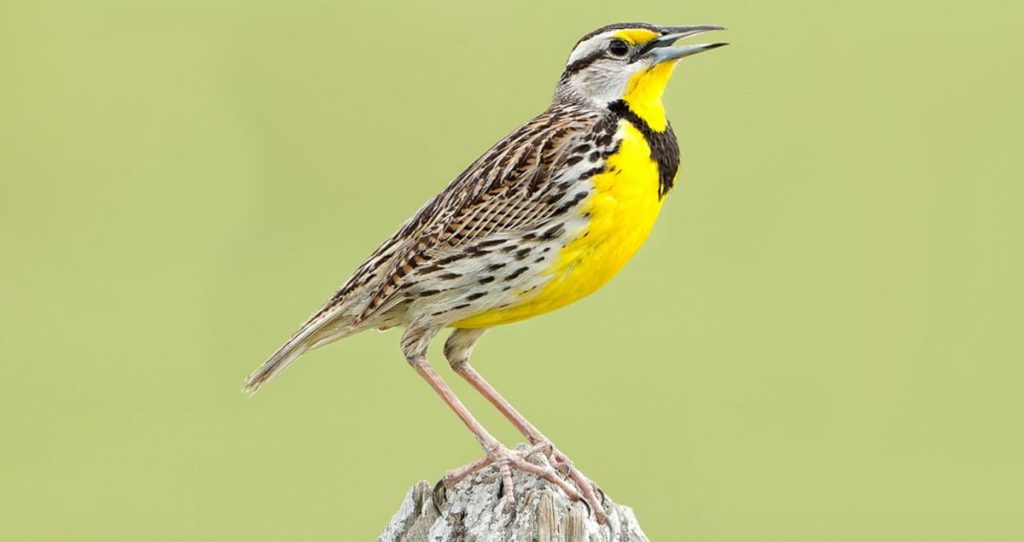
Eastern Meadowlarks, considered a near-threatened species, are present in Louisiana throughout the year. They are recorded in 11% of both summer and winter checklists. These medium-sized songbirds showcase bright yellow undersides, pale brown coloring with black marks on their backs, and a distinctive black band across the chest.
Scientifically referred to as Sturnella magna, Eastern Meadowlarks inhabit eastern US states year-round, with breeding populations in the Northeast and Canada. They offer mesmerizing displays and songs during the arrival of spring, signifying the awakening of the East. Unfortunately, their near-threatened status emphasizes the need for conservation efforts. Eastern Meadowlarks can be found in grasslands, prairies, and large fields during winter, where they search for seeds in flocks.
8. Cedar Waxwing:
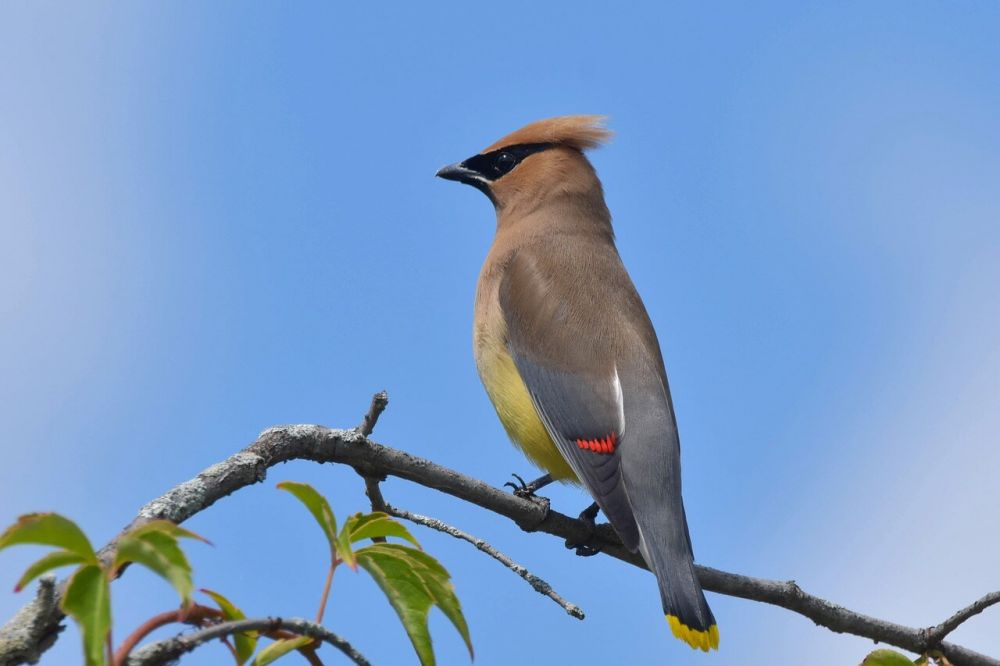
Cedar Waxwings are primarily spotted in Louisiana during winter, accounting for 12% of checklists during this season. Their presence is notable from November to May.
These elegant and sociable birds exhibit pale brown plumage on their heads, chests, and crests, transitioning to gray on their backs and wings. Their bellies showcase a pale yellow hue, and their wingtips feature a bright red accent. Additionally, Cedar Waxwings possess a narrow black mask across their eyes.
Scientifically known as Bombycilla cedrorum, Cedar Waxwings breed in Canada before migrating to the southern United States, Mexico, and Central America for winter. They are residents in northern US states throughout the year. These waxwings are commonly found in berry bushes, woodlands, grasslands, towns, and along streams. They primarily feed on fruit, but also consume insects during the summer. The nests of Cedar Waxwings are built using twigs, grass, hair, and plant material, lined with pine needles and soft grass. They lay up to six eggs, which hatch in around twelve days, and the young leave the nest after another sixteen days or so.
9. Summer Tanager (Female):
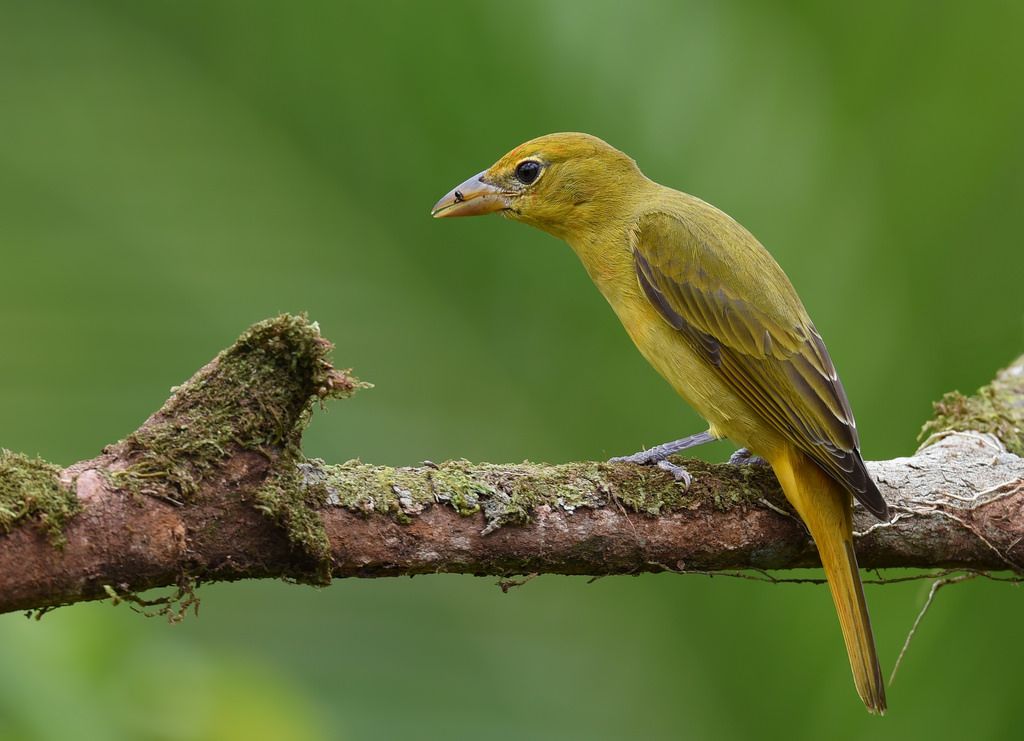
During the breeding season from April to October, Summer Tanagers are frequently observed in Louisiana, accounting for 15% of checklists during this period.
Female Summer Tanagers exhibit a predominantly greenish-yellow plumage, with paler undersides and darker backs, wings, and white wingbars.
Scientifically referred to as Piranga rubra, Summer Tanagers breed in southern and eastern US states before migrating to Central and South America for winter. They can be found during migration in most US states, excluding the northeastern region. These tanagers inhabit open woodlands and feed on bees and wasps mid-flight, capturing and killing them by beating against a branch and removing the stinger before consumption.
10. Orchard Oriole (Female):
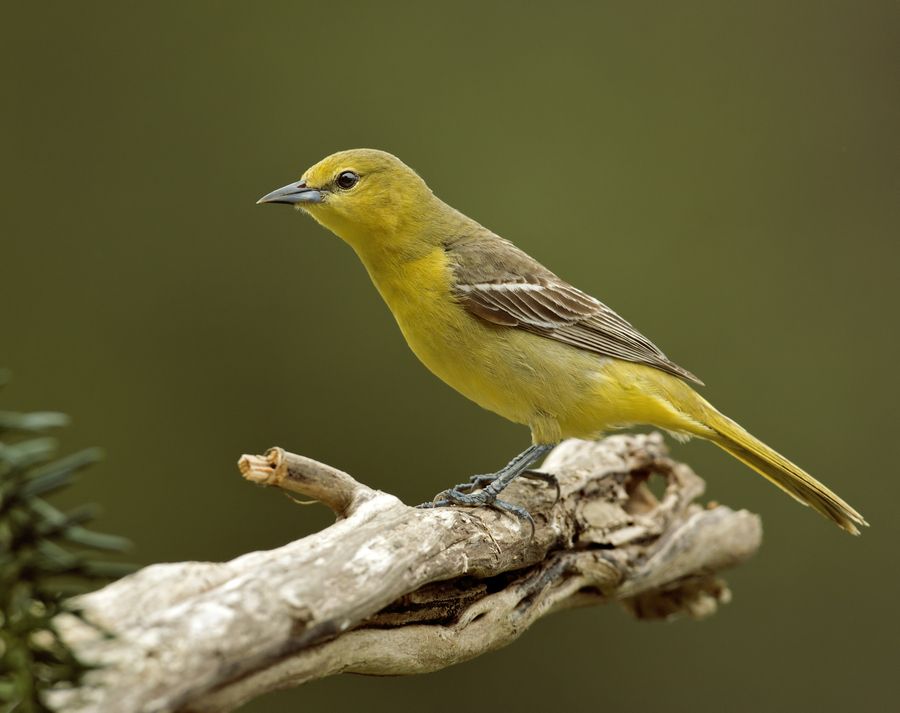
Orchard Orioles are present in Louisiana during the breeding season, from April until mid-September, and appear in approximately 17% of summer checklists.
Female Orchard Orioles showcase greenish-yellow overall plumage, with paler undersides and darker backs, along with darker wings and white wingbars.
Scientifically known as Icterus spurius, Orchard Orioles breed in the eastern half of the United States before migrating south to Mexico and Central America for winter. These orioles can be found in open woodlands, along riverbanks, open shrublands, farms, and even backyards. They construct hanging pouch-like nests and predominantly feed on insects such as ants, caterpillars, beetles, and grasshoppers. They also consume spiders, nectar from flowers, and various fruits like mulberries and chokeberries.
These are just a few examples of the 32 yellow birds found in Louisiana. Each species adds its unique charm to the avian diversity of the region. So, keep your eyes peeled and enjoy the beauty of these vibrant feathered creatures!
11. Prothonotary Warbler:
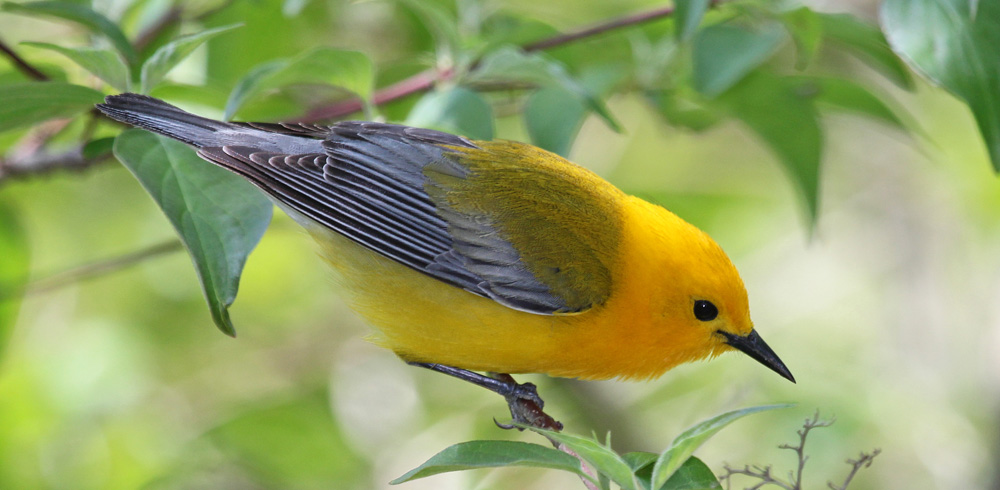
Prothonotary Warblers are prominent summer visitors to Louisiana, commonly observed from April to October. They are noted in approximately 17% of summer checklists.
Prothonotary Warblers display vibrant yellow plumage with blue-gray wings and a touch of orange on their heads. These warblers prefer wetland habitats, such as swamps and marshes, where they build their nests in tree cavities or nest boxes near water bodies.
12. Hooded Warbler:
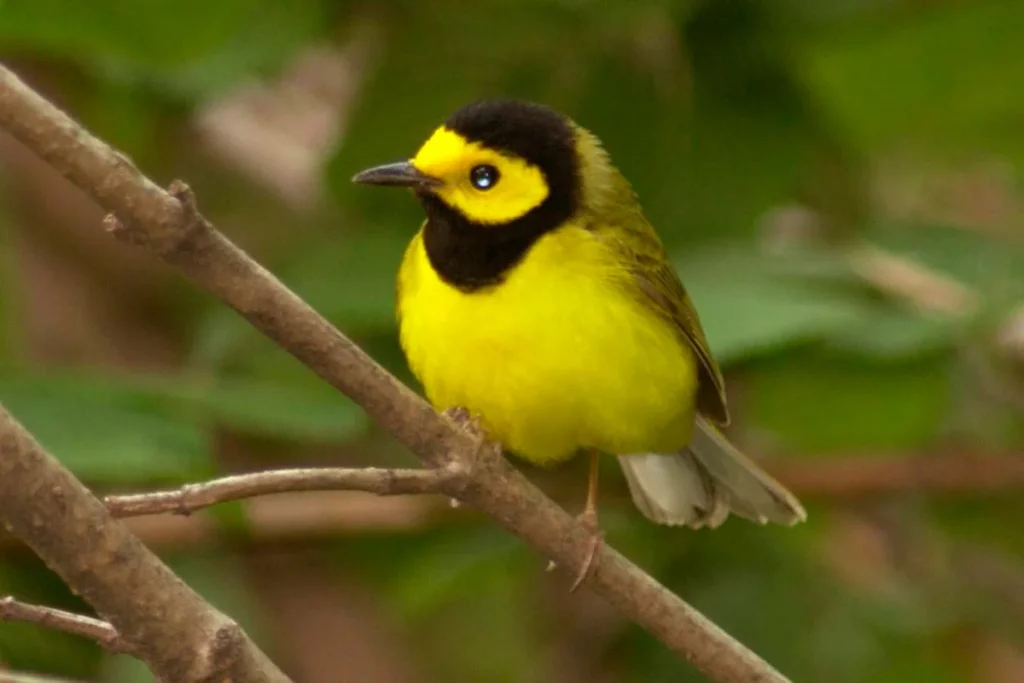
Hooded Warblers can be spotted in Louisiana during the summer season, making up around 15% of summer checklists.
With their distinct black hoods and bright yellow faces and bodies, Hooded Warblers are easily recognizable. They inhabit dense shrubby areas and understory vegetation in forests. Their melodious songs can be heard echoing through the trees during the breeding season.
13. Painted Bunting:
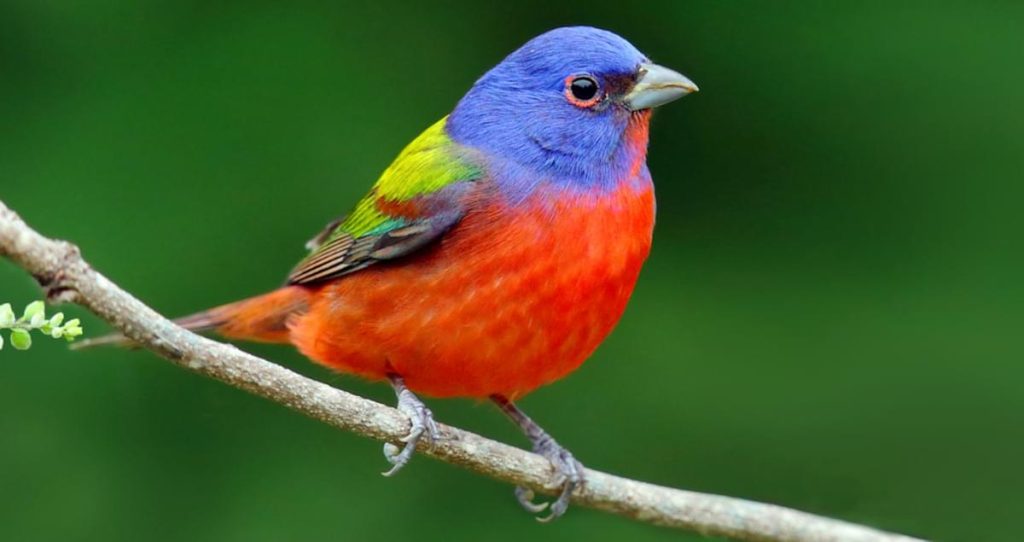
Painted Buntings are strikingly colorful birds that grace Louisiana during the summer months. They occur in approximately 11% of summer checklists.
Male Painted Buntings showcase a remarkable combination of bright blue heads, red breasts, and green backs. Females are comparatively more subdued, with greenish-yellow plumage. These buntings prefer brushy habitats, including woodland edges and overgrown fields.
14. Yellow-throated Vireo:

Yellow-throated Vireos are summer visitors to Louisiana, often seen from April to October. They are recorded in about 6% of summer checklists.
Featuring yellow throats, olive-green backs, and white wingbars, these vireos add a touch of brightness to the foliage. They primarily reside in deciduous forests, where they forage for insects amidst the tree canopies.
15. Baltimore Oriole:

Baltimore Orioles can be spotted in Louisiana during the summer months, constituting around 5% of summer checklists.
Male Baltimore Orioles are well-known for their vibrant orange plumage and contrasting black heads. Females exhibit a more subdued yellowish hue. These orioles inhabit a variety of wooded habitats, including parks, gardens, and forest edges, where they construct intricate hanging nests.
16. Yellow-throated Warbler:
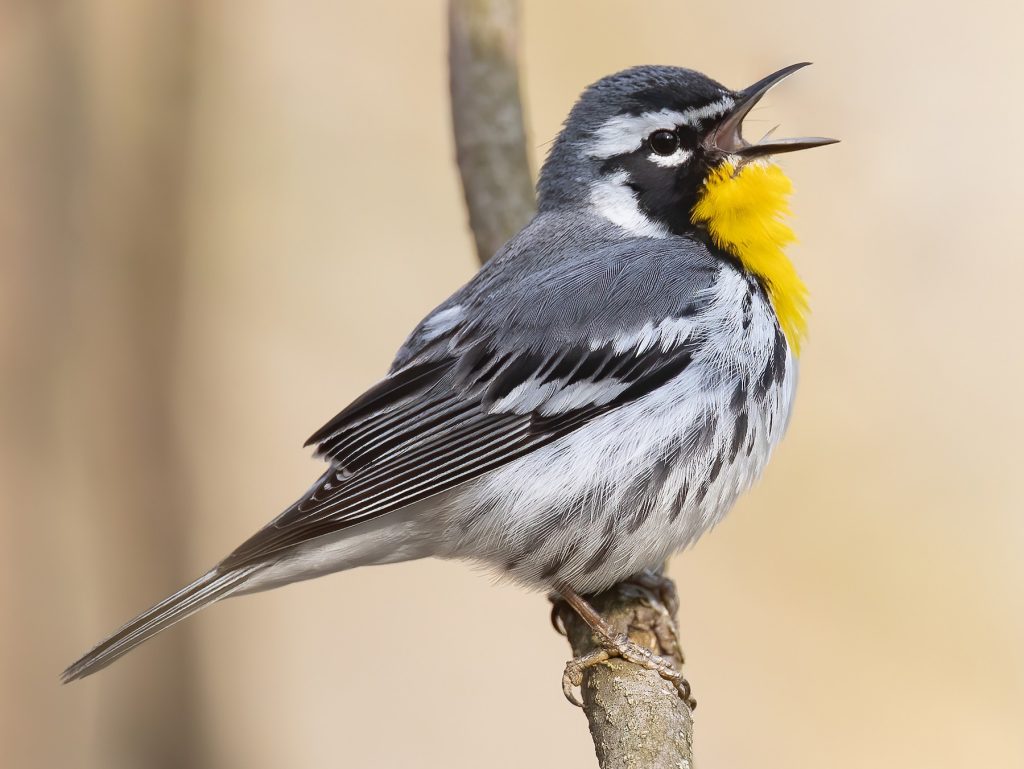
Yellow-throated Warblers are present in Louisiana during the summer season, accounting for about 5% of summer checklists.
Featuring yellow throats, gray backs, and white wingbars, these warblers showcase an elegant appearance. They inhabit mature forests, particularly those near water bodies, where they actively search for insects.
17. Dickcissel:
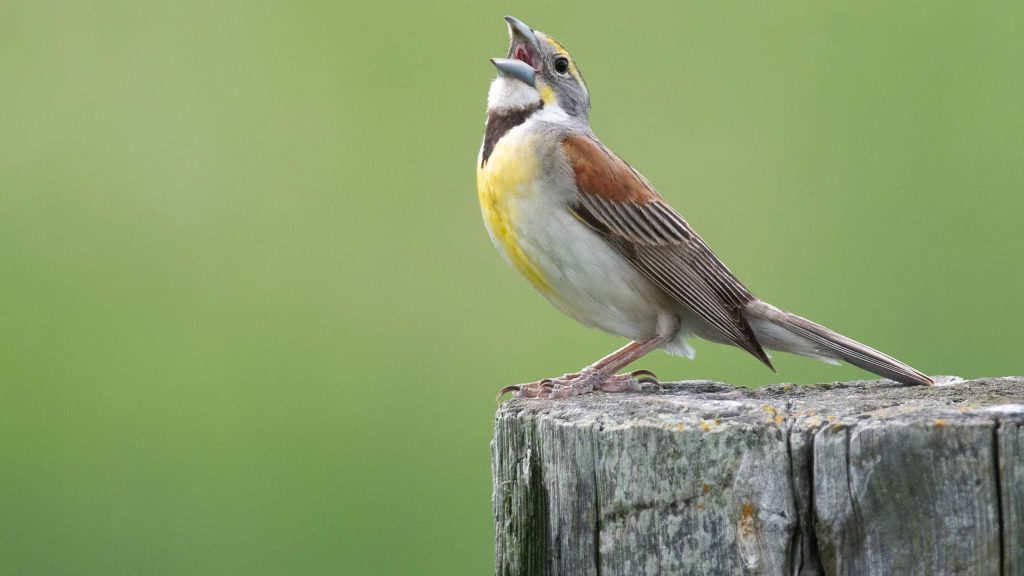
Dickcissels are primarily seen in Louisiana during the summer months, making up around 5% of summer checklists.
These sparrows exhibit distinctive black throats, yellow breasts, and brownish upperparts. They are often found in grasslands, agricultural fields, and prairies, where they forage for seeds and insects.
18. Prairie Warbler:
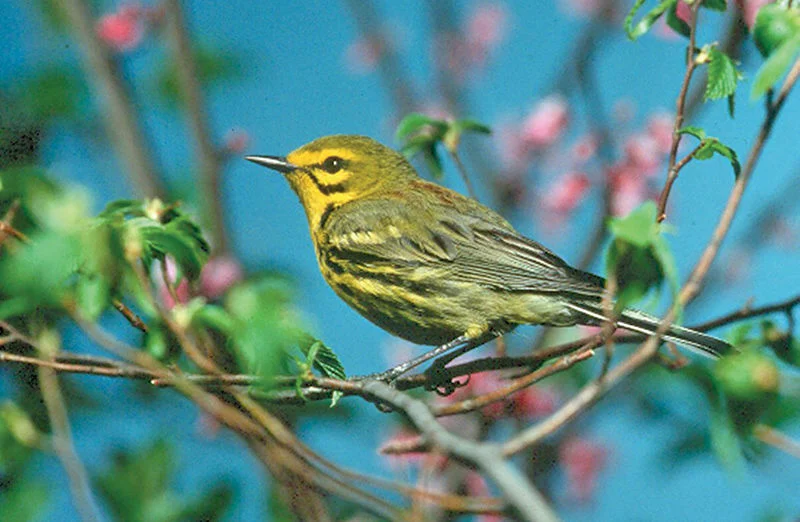
Prairie Warblers are common summer visitors to Louisiana, occurring in approximately 5% of summer checklists.
With their yellow underparts, black streaks on their sides, and olive-green upperparts, Prairie Warblers present a charming appearance. They prefer shrubby habitats, including open woodlands and scrubby fields, where they actively search for insects.
19. Yellow-rumped Warbler (Audubon’s):

Audubon’s Yellow-rumped Warblers can be spotted in Louisiana during the winter months, constituting approximately 15% of winter checklists.
These warblers feature grayish-blue backs, yellow throats, and yellow patches on their sides. They are often found in a variety of habitats, including coniferous forests, woodlands, and open areas with fruiting shrubs.
20. American Goldfinch:

As mentioned earlier, American Goldfinches are commonly observed in Louisiana during the winter season. They occur in approximately 32% of winter checklists.
Male American Goldfinches display bright yellow plumage during the breeding season, while females and winter males have a duller brown appearance. They can be found in various habitats, including weedy fields, suburbs, parks, and backyards, where they feed on seeds and visit bird feeders.
21. Orange-crowned Warbler:

Orange-crowned Warblers, previously discussed, are winter visitors to Louisiana, occurring in around 26% of winter checklists.
These warblers have yellow-olive coloring, with the intensity of yellow varying geographically. Their orange crown is seldom visible. They inhabit shrubby areas, low vegetation, and open woodlands, where they forage for spiders, insects, berries, and seeds.
22. Cedar Waxwing:

Cedar Waxwings, previously mentioned, are frequently seen in Louisiana during the winter season, accounting for about 12% of winter checklists.
These sociable birds feature pale brown plumage, crests, and distinctive black masks. They can be found in berry bushes, woodlands, grasslands, towns, and along streams, feeding mainly on fruit, insects, and nectar.
23. Palm Warbler:
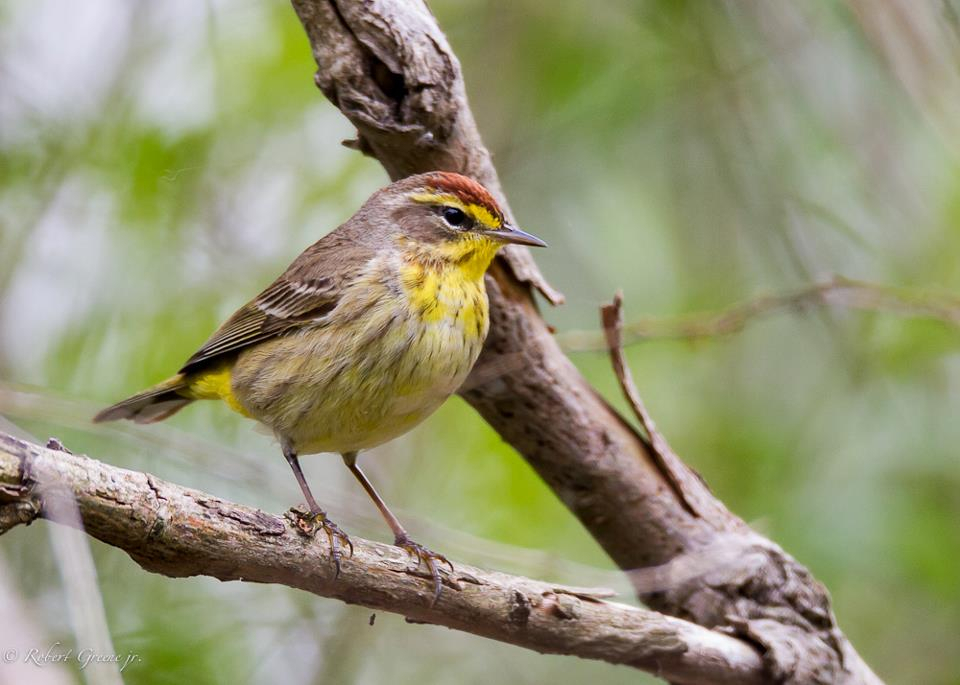
Palm Warblers are winter visitors to Louisiana, typically observed from September to April. They are recorded in approximately 10% of winter checklists.
These warblers display yellow underparts with rusty-brown streaking, olive-brown upperparts, and a distinctive rusty cap. They inhabit a range of habitats, including forests, fields, and marshes, where they actively search for insects and occasionally consume berries.
24. Wilson’s Warbler:
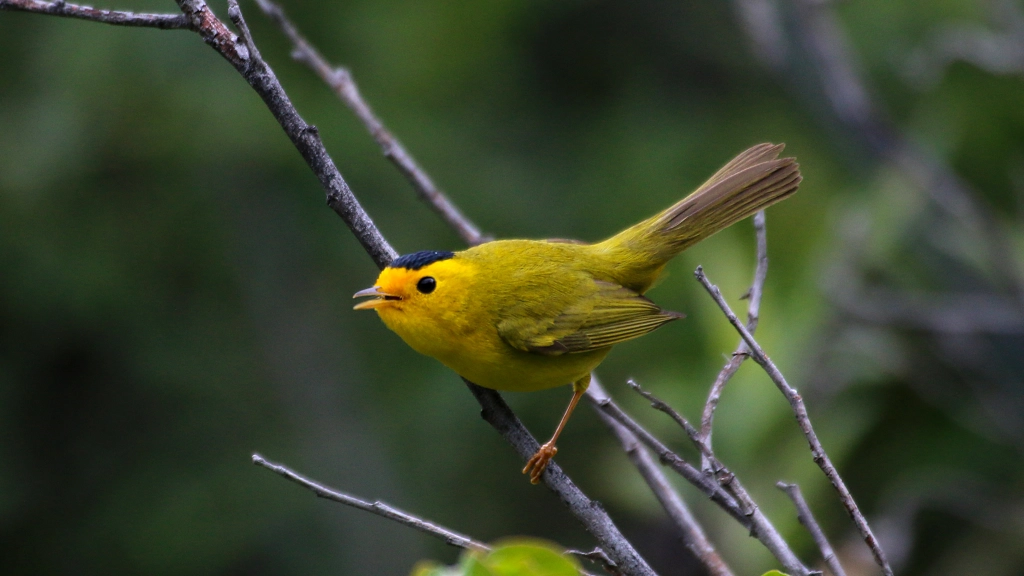
Wilson’s Warblers are winter visitors to Louisiana, occurring in around 9% of winter checklists.
With their bright yellow underparts, olive-green upperparts, and a distinctive black cap, these warblers stand out. They are often found in dense vegetation near water, including marshes and wetlands, where they forage for insects.
25. Western Kingbird:
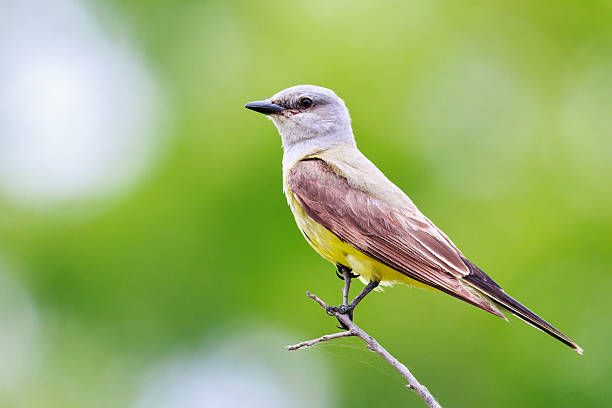
Western Kingbirds can be seen in Louisiana during the winter months, making up around 4% of winter checklists.
These flycatchers exhibit yellow underparts, grayish-brown upperparts, and a pale gray head. They inhabit open areas, including fields, meadows, and forest edges, where they feed on insects and occasionally consume berries.
26. Yellow-headed Blackbird:

Yellow-headed Blackbirds are winter visitors to Louisiana, typically observed from September to April. They occur in approximately 3% of winter checklists.
With their striking yellow heads and black bodies, these blackbirds make quite an impression. They often inhabit wetland areas, such as marshes and rice fields, where they forage for insects, seeds, and grains.
27. Western Meadowlark:
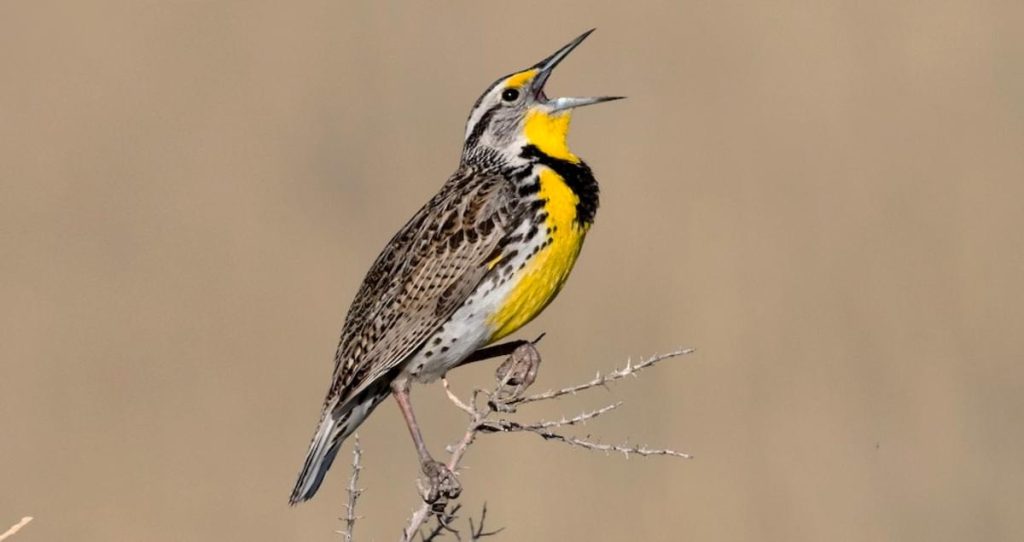
Western Meadowlarks are winter visitors to Louisiana, commonly seen from November to April. They are recorded in around 3% of winter checklists.
Similar to Eastern Meadowlarks, Western Meadowlarks display bright yellow underparts with brownish upperparts and a distinct black V-shaped pattern on their chests. They prefer open grasslands, prairies, and agricultural fields, where they feed on insects and seeds.
28. Yellow Warbler:

Yellow Warblers are migratory birds passing through Louisiana during their migration periods. They occur in approximately 3% of checklists during migration.
These warblers are characterized by their bright yellow plumage, often accompanied by reddish streaks on their breasts. They inhabit various habitats, including forests, wetlands, and shrubby areas, where they actively forage for insects.
29. American Redstart:

American Redstarts are migratory birds that can be observed during their migration periods in Louisiana. They make up around 2% of checklists during migration.
Male American Redstarts exhibit black upperparts with bright orange patches on their sides and tails, while females have olive-green upperparts and yellow underparts. They are often found in deciduous forests and wooded areas, where they actively hunt insects.
30. Magnolia Warbler:

Magnolia Warblers are migratory birds that pass through Louisiana during their migration periods. They occur in approximately 2% of checklists during migration.
These warblers showcase striking yellow underparts, black streaks on their sides, and a distinctive black necklace pattern. They prefer forested areas, including both coniferous and deciduous forests, where they actively search for insects.
31. Scarlet Tanager:

Scarlet Tanagers are migratory birds that can be observed during their migration periods in Louisiana. They make up around 2% of checklists during migration.
Male Scarlet Tanagers display brilliant scarlet plumage, while females exhibit a more subdued olive-green coloration. They inhabit deciduous forests, where they forage for insects and occasionally consume fruits.
32. Black-throated Green Warbler:
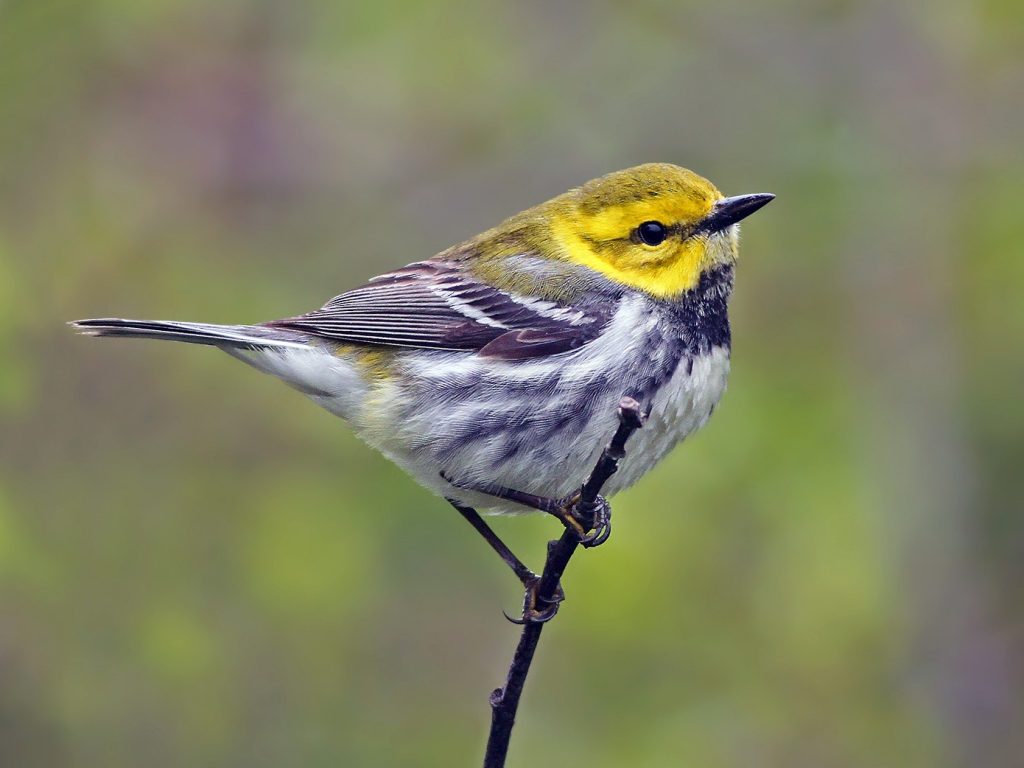
Black-throated Green Warblers are migratory birds passing through Louisiana during their migration periods. They occur in approximately 2% of checklists during migration.
These warblers feature yellow underparts, olive-green upperparts, and a black throat and face. They prefer mixed forests, including both coniferous and deciduous trees, where they actively feed on insects.
These 32 yellow birds encompass a diverse array of species that grace Louisiana’s skies throughout the year, offering a vibrant tapestry of colors and melodies to nature enthusiasts and birdwatchers alike.
